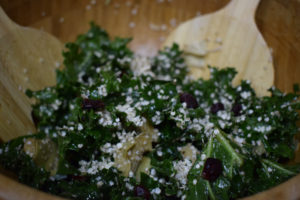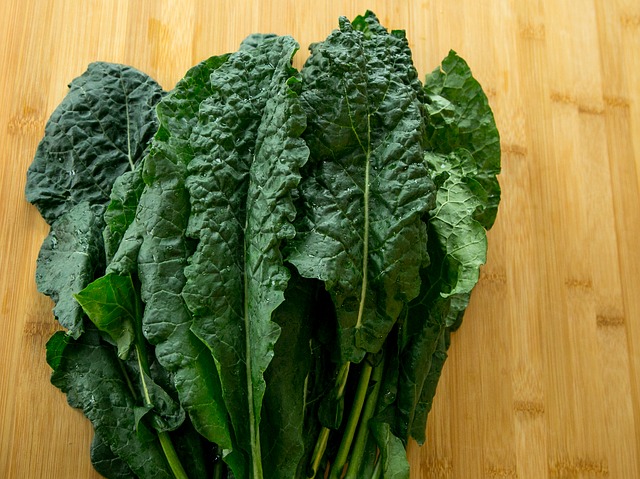I crossed the garden of Kale in one of my raw cooking classes. What was this beautiful, crispy and strong vegetable? This magnificent plant is a member of the cabbage family, related also to broccoli, cauliflower and collard greens. There are different types and its colours vary from shades of green to purple. Its texture can be smooth, and curly. My favourite one is “Dinosaur Kale” because it is rougher and the texture is thicker than the regular kale. Its shade of green is darker.
The stem and veins of Kale has a strong and bitter taste, so cutting them is better for flavor when making salads, however, it is best to leave them for juices as these parts contain most of the fiber, and in a smoothy or juice the taste can always be camouflage using a lot of berries.
The most important part when making a Kale salad is to massage the vegetable with the dressing you are using, that way the infusion of oils penetrates the leaves. I personally enjoy the healthiest, and simplest dressing: lemon, olive oil and balsamic vinegar. Once you have added these ingredients, massage the Kale with love and presence. Then add any other protein, vegetable, or nut. Because Kale is already loaded with proteins and many nutrients, I usually do not add meats. Instead, I prefer to add nuts, and dried berries. I like to keep it simple. But the beautiful thing about this super vegetable is the fact that you can mix and match with any other ingredients. The clue to me is to have always a nut, and a dried berry or fruit to give it a sweet taste and balance its strong essence.
*My original Kale salad has dried cranberries and pine nuts (or pumpkin seeds). Being honest, I am not one who measures exactly every ingredient. With this said, I usually add a mix of olive oil with balsamic vinegar (already pre-made), 1 small lemon or 1/2 of a big one, salt and pepper to taste.

Ideas of super healthy toppings to add
- Quinoa with slices of pear (and feta cheese)
- Quinoa flakes to the original Kale salad
- Baked salmon with small pieces of fresh orange
- Avocado, dried cranberries and pecans
- Strawberries and slices of roasted almonds (or walnuts)
Kale is such a versatile vegetable that I just make-up the salads as I go, considering what is available in the market or at home.
Amazing benefits of Kale:
- Low Calories: High in water and fiber content, and no fat, because it contains the good fats, AKA as omega-3
- Anti-inflammatory: These omega-3 fatty acids help fight against arthritis, asthma and autoimmune disorders.
- Antioxidants: Large amounts of flavonoids. Antioxidants counteract the process of the oxidative damage caused by free radicals in our bodies, which come from pollutants in the environment, cigarettes, genetically modified and synthetic foods.
- Iron: Per calorie, kale has more iron than beef, which is essential for the formation of hemoglobin and enzymes
- Cardiovascular support: Through bile acid sequestrants Kale lowers cholesterol levels in the body
- Vitamin K: A nutrient critical for blood clotting and activates certain proteins allowing them to bind calcium.
- Vitamin C: a water-soluble antioxidant. This vital piece serves in many important functions such as synthesizing collagen.
- Beta-Carotene: An antioxidant that the body is able to turn into Vitamin A plays a major role in development, differentiation, and support of various tissues and organs.
- Protective effects against cancer: It is loaded with compounds (sulforaphane and indole-3-carbinol) which have been shown to help fight the formation of cancer at the molecular level
- Important Minerals: Calcium, Potassium and Magnesium
A single cup of raw kale (about 67 grams or 2.4 ounces) contains:
- Vitamin A: 206% of the RDA (from beta-carotene).
- Vitamin K: 684% of the RDA.
- Vitamin C: 134% of the RDA.
- Vitamin B6: 9% of the RDA.
- Manganese: 26% of the RDA.
- Calcium: 9% of the RDA.
- Copper: 10% of the RDA.
- Potassium: 9% of the RDA.
- Magnesium: 6% of the RDA.
Then it contains 3% or more of the RDA for Vitamin B1 (Thiamin), Vitamin B2 (Riboflavin), Vitamin B3 (Niacin), Iron and Phosphorus.
A total of 33 calories, 6 grams of carbs (2 of which are fiber) and 3 grams of protein. For these many nutritional values, organic Kale is always in the grocery list, making its way to my home, where we use it in salads, green juices, and soups.
Resources:
www.mindbodygreen.com
www.authoritynutrition.com

